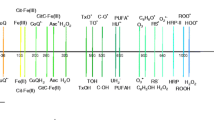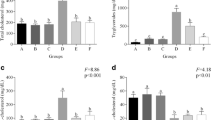Abstract
Atherosclerosis is a chronic inflammatory disease of multiple etiologies. It is associated with the accumulation of oxidized lipids in arterial lesions leading to coronary heart disease. 3-Hydroxy-3-methylglutaryl coenzyme A (HMG-CoA) reductase inhibitors (commonly known as statins) are widely used in cardiovascular disease prevention to lower the cholesterol. The antioxidant activity of HMG-CoA reductase inhibitors was studied by lipid peroxidation inhibition assay, DPPH, and hydroxyl radical scavenging-activity methods. The lovastatin (93%) and simvastatin (96%) showed significant action of lipid peroxidation inhibition compared to other HMG-CoA reductase inhibitors. The DPPH radical and hydroxyl radical scavenging activity of simvastatin was 38% and 33%, respectively. The oxidative modification of serum lipid due to reactive oxygen species causes atherosclerosis. This study revealed the importance of lovastatin and simvastatin to prevent oxidative stress-related cardiovascular diseases.




Similar content being viewed by others
References
Istvan, E. (2003). Atherosclerosis. Supplements, 4, 3–8.
Istvan, E., & Deisenhofer, J. (2001). Science, 292, 1160–1164.
Brown, A. (2007). Clinical and Experimental Pharmacology & Physiology, 3, 135–141.
Plosker, G., & Wagstaff, A. (1996). Drugs, 51, 433–459.
Manzoni, M., & Rollini, M. (2002). Applied Microbiology and Biotechnology, 58, 555–564.
Suzumura, K., & Narita, H. (1999). Chemical & Pharmaceutical Bulletin, 47, 1477–1480.
Suzumura, K., & Suzuki, T. (1999). Biochemical Pharmacology, 57, 697–703.
Mitani, H., & Hayashi, S. (1996). British Journal of Pharmacology, 119, 1269–1275.
Meneghini, R. (1997). Free Radical Biology & Medicine, 23, 783–792.
Stadtman, E., & Berlett, B. (1998). Drug Metabolism Reviews, 30, 225–243.
Butterfield, D., & Scapagnini, G. (2002). The Journal of Nutritional Biochemistry, 13, 444–461.
Pryor, W., & Ann, N. (1982). Academic Science, 393, 1–22.
Sastre, J., & Viña, J. (2000). Free Radical Research, 32, 189–198.
Corsini, A., & Soma, V. (1996). Cardiologist, 87, 458–468.
Dhale, M., & Vijayalakshmi, G. (2007). Journal of Applied Microbiology, 103, 2168–2173.
Blois, M. (1958). Nature, 181, 1199–1200.
Singh, R., & Jayaprakasha, G. (2002). Journal of Agricultural and Food Chemistry, 50, 81–86.
Steinberg, D., & Witztum, J. (1989). The New England Journal of Medicine, 320, 915–924.
Henriksen, T., & Steinberg, D. (1981). Proceedings of the National Academy of Sciences of the United States of America, 78, 6499–6503.
Kunjathoor, V., & Freeman, M. (2002). The Journal of Biological Chemistry, 277, 49982–49988.
Vaya, J., & Aviram, M. (2001). Current Medicinal Chemistry, 18, 99–117.
Gordon, M. (2001). Measuring antioxidant activity. In J. Pokorny, N. Yanishlieva, & M. Gordon (Eds.), Antioxidants in food: practical applications (pp. 71–84). Cambridge: Woodhead Publishing.
Baskar, A., & Subramanian, P. (2004). Cellular & Molecular Biology Letters, 9, 665–673.
Takemoto, M., & Liao, J. (2001). The Journal of Clinical Investigation, 108, 1429–1437.
Chaudiere, J., & Ferrari-Iliou, R. (1999). Food and Chemical Toxicology, 37, 949–962.
Acknowledgement
H. P. Mohan-Kumari acknowledge CSIR, New-Delhi and Dr. V. Prakash, Director, CFTRI, Mysore for providing research fellowship and facility to carry out this work respectively. V. Gaonkar and S. Keni thank Dr. Satish R. Shetye, Director, NIO, Dona Paula, Goa for providing the facility to carry out this work.
Author information
Authors and Affiliations
Corresponding author
Rights and permissions
About this article
Cite this article
Puttananjaiah, MK.H., Dhale, M.A., Gaonkar, V. et al. Statins: 3-Hydroxy-3-methylglutaryl-CoA (HMG-CoA) Reductase Inhibitors Demonstrate Anti-Atherosclerotic Character due to Their Antioxidant Capacity. Appl Biochem Biotechnol 163, 215–222 (2011). https://doi.org/10.1007/s12010-010-9031-z
Received:
Accepted:
Published:
Issue Date:
DOI: https://doi.org/10.1007/s12010-010-9031-z




